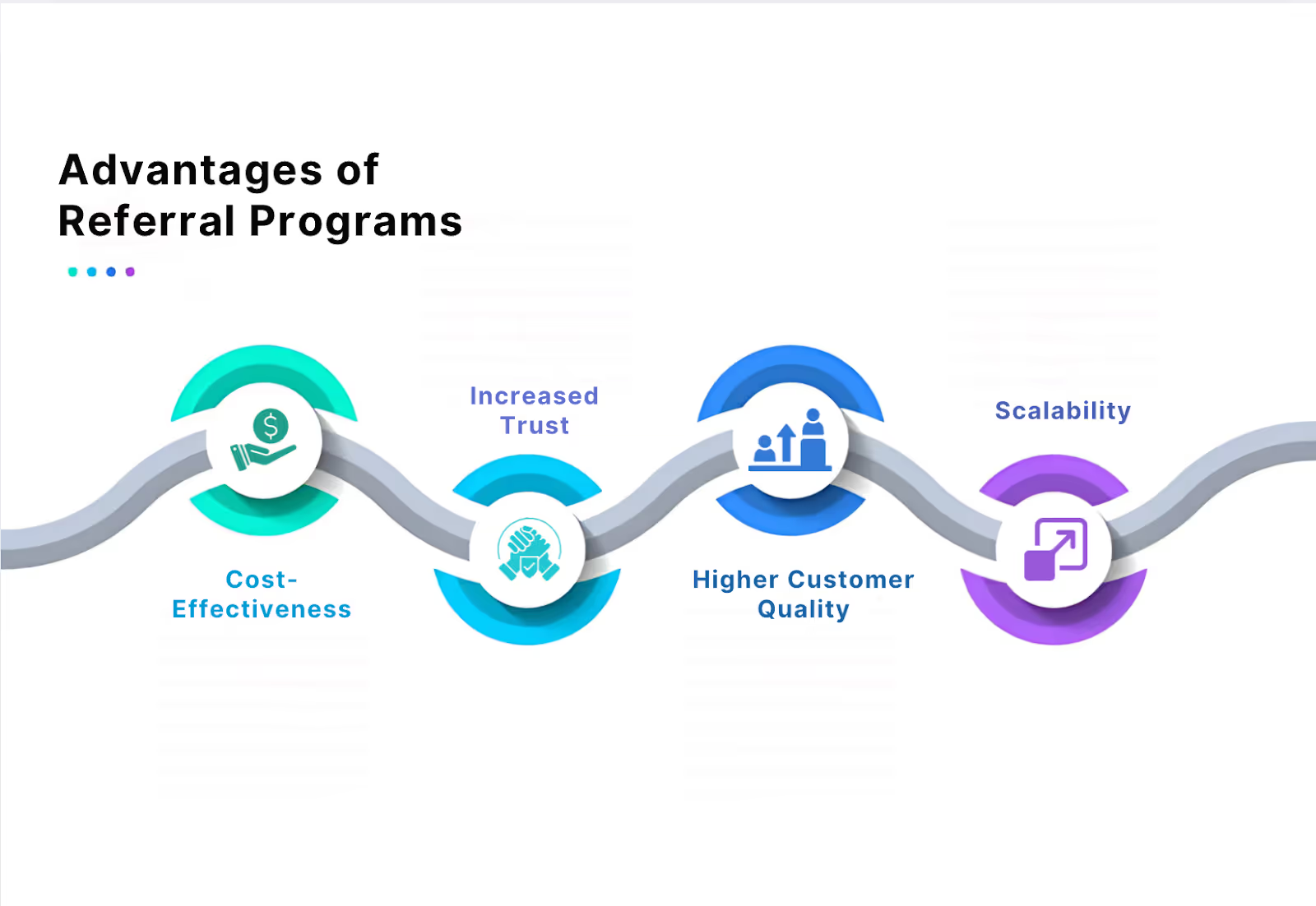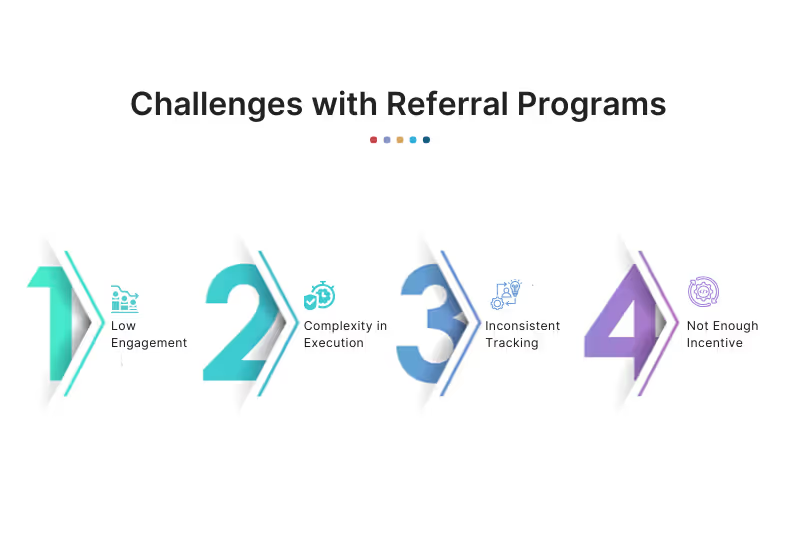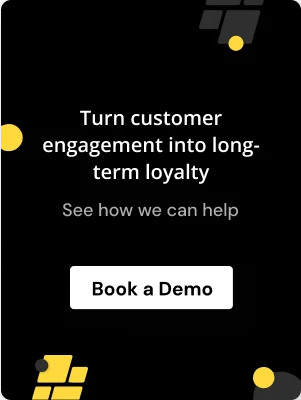.avif)
.avif)
Referral programs have become quite popular recently. It is one of the most effective tools for customer acquisition. With traditional advertising becoming increasingly costly and less reliable, referrals offer a cost-effective, trustworthy alternative.
In fact, studies even suggest that referred customers have a higher lifetime value, with the average purchase value of a referred customer being at least 16% higher than that of a non-referred one.
By encouraging your current customers to share their experiences, referral programs not only reduce acquisition costs but also drive significant growth through high-quality leads.
In this blog, we’ll explore how you can utilize referral programs to drive customer acquisition and foster organic growth.
Key Takeaways:
- Referral programs offer a cost-effective strategy for attracting quality customers while lowering marketing expenses.
- Trust-driven marketing through referrals leads to faster conversions and higher customer loyalty.
- Referred customers are more engaged and stay longer, enhancing customer lifetime value.
- Scaling a referral program is easier and less costly compared to traditional marketing efforts.
- Automation simplifies tracking and reward distribution, making the referral process seamless for both customers and businesses.
Why Are Referral Programs Important in 2025?
Referral programs are gaining momentum as traditional advertising becomes more costly and less effective. With paid ads losing their reliability, referrals have become a key driver of organic growth.
Studies show that 92% of consumers trust recommendations from family and friends more than any other form of advertising. Referrals build this trust, offering a more genuine and authentic marketing approach.
Additionally, referred customers are typically high-quality leads, converting more quickly and often leading to repeat purchases and lasting relationships.
How Referral Programs Work & Why They’re Effective?
Referral programs are based on a simple yet powerful concept, i.e., word-of-mouth marketing. It’s a strategy that motivates current customers to advocate for your brand by offering rewards in return. Referred customers are more likely to purchase since they trust the person who referred them, leading to higher conversion rates. Here’s a breakdown on how the program works:
- Define Clear Goals: Set specific objectives like new sign-ups, increased sales, or repeat business to shape your referral strategy.
- Choose the Right Incentives: Align rewards with your audience’s interests: discounts, free products, or exclusive offers that motivate action.
- Make the Process Easy: Simplify referral steps. Provide easy links to share, track, and redeem rewards to encourage participation.
- Promote: Use email, social media, and your website to maximize visibility and keep the program top of mind.
Also Read: Guide to Starting a Successful Referral Business
What Are the Main Advantages of Referral Programs?
Referral programs offer businesses a cost-effective and trustworthy way to acquire new customers. They generate high-quality leads, build brand credibility, and foster long-term growth through organic advocacy.

1. Cost-Effectiveness
Referral programs are a cost-efficient solution, as they require less upfront investment compared to traditional paid advertising. Instead of paying for ads, you incentivize existing customers to do the marketing for you. This helps in reducing customer acquisition costs while helping businesses to scale without heavy spending.
2. Increased Trust
Trust is a major factor in customer buying decisions, and referrals naturally come with built-in credibility. As customers trust recommendations from friends or family over advertisements, they can quickly make decisions. This trust-driven marketing approach often results in higher conversion rates, as referred customers are already inclined to make purchases based on their trusted connections.
3. Higher Customer Quality
Referred customers are not only more likely to buy, but they also tend to be more loyal and engaged with the brand. Since they come from a trusted source, they have a stronger connection to your business, often resulting in longer customer lifecycles, higher lifetime value, and frequent repeat purchases. This quality-over-quantity approach significantly boosts long-term business growth.
4. Scalability
Unlike traditional marketing that often requires substantial budget increases to reach a larger audience, referral programs scale naturally. As customers refer others, your program grows exponentially without huge investments in advertising or promotional campaigns.
With the right incentives and a seamless process, referral programs allow for organic business growth that’s easy to maintain and doesn’t drain resources.
Why Customer Referrals Drive Better Conversion Rates?
Customer referrals are one of the most powerful tools for driving higher conversion rates. Here's why they work so effectively:
- Built-in Trust: Referrals come from people customers know and trust, making them more likely to trust your brand.
- Faster Decision-Making: With trust already established, referred customers make quicker purchase decisions.
- Lower Sales Cycle: Since referrals skip over the need for persuasion, sales processes become quicker and smoother.
- Higher Engagement: Referred customers are often more engaged with your brand, leading to longer-term relationships.
- Better Fit Customers: Referrals attract prospects who already align with your brand, improving overall customer quality and loyalty.
However, the effectiveness of a referral program depends on its design and execution. With Nector’s referral solutions, businesses can automate and streamline the referral process, ensuring a smooth, seamless experience for customers. Its intuitive interface and quick integration enable effortless scaling, driving increased customer acquisition and long-term retention.
How to Build a Referral Program: Step-by-Step
Creating an effective referral program doesn’t have to be complicated. Here's a streamlined approach to ensure your referral program delivers results:
1. Define Your Goals
Before you get started, it's important to be clear about what you want your referral program to accomplish. Your goals influence every aspect of the program, including rewards and messaging.
Here’s what you need to ask yourself:
- Looking to grow your customer base? Focus on incentives for first-time sign-ups.
- Want to boost sales volume? Offer discounts or freebies based on purchase size.
- Seeking to improve repeat purchases? Provide rewards after customers place multiple orders or engage with your brand frequently.
Set specific, measurable goals, like "Increase customer sign-ups by 25% each month." This clarity makes your program more actionable and easier to evaluate.
2. Select the Right Rewards
Your reward should not only be valuable but also resonate with your audience’s interests. Tailor the reward based on your customer base for maximum impact.
Here are the reward ideas to choose from:
- Discounts or credits: Simple and effective, like “$5 off your next purchase.”
- Exclusive perks: Provide access to limited products, VIP-only invites, or behind-the-scenes experiences.
- Tiered rewards: Encourage more referrals with incentives like “Refer 3 friends for 10% off; 5 friends earn a free product.”
Choosing rewards that align with your audience’s values ensures they’ll engage more with your program. Understand what motivates your customers, and adapt your rewards accordingly.
Also Read: Digital Reward Options for Employees and Customers
3. Streamline the Referral Process
A major reason why referral programs fail is complexity. Make the process as smooth as possible to increase participation and keep your customers engaged.
Here’s what you should offer:
- Easy access: Provide a simple referral link that customers can easily share.
- Trackable progress: Allow customers to track their referrals and reward status.
- Clear instructions: Ensure users know exactly what to do and what they’ll get at each step.
By keeping the process intuitive, you turn “I’ll refer later” into “I’ll share now,” driving immediate action from your customers.
4. Automate Tracking and Rewards
To ensure a smooth experience and trust in your program, automate referral tracking and reward distribution. This removes any guesswork for customers and helps build credibility. You can do so seamlessly with the help of a tool like Nector.
With automation, platforms like Nector handle:
- Referral link generation: Automatically generate personalized referral links for each customer.
- Real-time tracking: Track sign-ups and purchases instantly.
- Instant notifications: Notify customers when rewards are earned.
Automation ensures your team can focus on other priorities while the system takes care of the rest. This makes referrals effortless for both your customers and your team.
5. Promote Your Referral Program
Even the best program won’t work if your customers don’t know about it. You need to weave it into every customer touchpoint to ensure visibility and participation.
Here’s how to promote your program via:
- Emails: Send referral invitations in post-purchase emails or thank-you messages.
- Website banners: Use subtle pop-ups on your homepage or product pages to promote the program.
- Post-checkout: Remind customers of referral opportunities right after they make a purchase.
- Social media: Share success stories and posts to highlight the rewards of referring.
Bonus tip: Spotlight real success stories, like “John earned a $20 gift card by referring 3 friends.” Seeing real customers benefit makes others more likely to participate.
Referral Rewards: Know What Works Best for Your Audience
Rewards are the backbone of any referral program. But which ones work best?
- Choosing the Right Reward: Cash, discounts, loyalty points, or exclusive access, choose what motivates your customers the most.
- Single vs. Double-Sided Rewards: Double-sided rewards (where both the referrer and the referee get a reward) tend to drive higher engagement, but single-sided rewards can work well too.
- Know How Much to Spend: Calculate the reward based on customer lifetime value to ensure profitability while offering a valuable incentive.
What Is the Role of Data in Optimizing Your Referral Program?
Data is important to measure and improve your referral program’s performance. Here’s how they help!
- Tracking and Analyzing Referral Data: Use analytics tools to track the effectiveness of your program and adjust as needed.
- Customer Insights: Analyzing referral data gives you a deeper understanding of customer preferences and behaviors.
- Refining Your Strategy: Based on customer feedback and the available data, iterate your program to ensure continuous improvement.
In short, data isn’t just numbers; it’s the key to making your referral program smarter, stronger, and more rewarding for everyone involved.
Challenges with Referral Programs and How to Overcome Them
Even the best referral programs face hurdles. Here’s how to tackle them and ensure your program runs smoothly and drives consistent results.

1. Low Engagement
Offer rewards that resonate with your customers’ interests and provide value they can’t ignore to increase participation.
2. Complexity in Execution
Keep the referral process simple for both the referrer and referee to ensure an easy and engaging experience.
3. Inconsistent Tracking
Utilize automated tools like Nector for seamless tracking, ensuring no referral goes untracked and rewards are distributed promptly.
4. Not Enough Incentive
Provide incentives that are attractive and meaningful to your audience, ensuring your rewards encourage continuous engagement and participation.
By addressing these challenges thoughtfully, you can create a referral program that not only runs smoothly but also keeps your customers engaged and motivated.
How Referral Programs Boost Brand Awareness and Social Proof?
Referral programs can easily turn your existing customers into powerful advocates for your brand.
Here’s how they help improve your brand’s visibility:
- Customers share their positive experiences with friends and family, introducing your brand to new, trusted potential buyers.
- By offering incentives, customers are motivated to refer others, making the process seamless and rewarding.
- Satisfied customers provide real feedback, boosting your brand's credibility with genuine recommendations.
- Encourage customers to share their experiences online. This amplifies brand visibility and reaches a larger audience.
- As customers continue to engage with your brand, they naturally spread the word, creating a cycle of organic growth.

Referral programs are a proven method to drive growth, and Nector makes it easier than ever to implement one that works for your business. Our platform helps you turn satisfied customers into brand advocates. They can then actively spread the word about your products without you spending the high costs of traditional advertising.
With Nector’s seamless referral system, you can automate tracking, reward distribution, and customer engagement, ensuring a smooth experience for both referrers and referees.
Plus, our integrations with over 50+ tools, you can streamline communication and reach customers across multiple channels. Sign up today and set up the best referral program for your business now!
44x ROI for an Indian Gardening Platform with Nector
An Indian online platform for gardening products utilized Nector to supercharge its customer engagement. By implementing a tailored loyalty program with tiered rewards, the brand created a VIP experience for customers, offering exclusive benefits as they advanced through levels.
Here’s what they did:
- Created a VIP program with exclusive rewards for each tier.
- Integrated a referral program to incentivize customer advocacy.
- Personalized benefits for loyal customers, enhancing their experience.
What they achieved:
- 44x return on investment (ROI).
- 20% successful referrals.
- 9.45% of revenue is driven by Nector.
Their referral program effectively turned satisfied customers into brand advocates, driving organic growth and acquisition.
Wrapping Up
Referral programs are a powerful, cost-effective tool to drive both customer acquisition and retention. By using your existing customer base, you tap into a network of trusted advocates who can help spread the word about your brand. This reduces your acquisition costs and also attracts high-quality leads. These new customers are more likely to convert, remain loyal, and refer others in return.
If you are planning to launch a referral program too, now is the time to take action. Whether you’re planning to do it for the first time or looking to optimize your current strategy, Nector is the best choice for your referral program.
So, quickly book a demo with us and start driving organic growth through trusted customer recommendations!
FAQs
What's it called when you get money for referring someone?
This is known as a referral reward or referral bonus. It's an incentive given to you for bringing in new customers, often in the form of cash, discounts, or other perks.
Why are referrals so powerful?
Referrals are powerful because they come from friends, family, or colleagues, who have already experienced your product or service. This builds credibility and significantly increases the likelihood of a conversion, as people are more likely to trust recommendations over traditional advertising.
What are the disadvantages of referral?
Referral programs can sometimes suffer from low participation if the rewards aren’t appealing enough. Additionally, inconsistent tracking or a complicated process may discourage referrals. It’s important to keep the experience seamless and the rewards enticing to maximize success.
Should I share my referral bonus with the person that I referred?
While it’s not necessary, sharing your referral bonus can be a great way to strengthen relationships and show appreciation. Offering a small token of your bonus could enhance the referral experience, creating goodwill and potentially motivating further referrals.
What are some bad referrals?
Bad referrals occur when someone refers a person who is not genuinely interested or doesn't fit well with the product or service. This can lead to low-quality leads, wasted time, and a poor customer experience. It’s essential to ensure your referrals are targeted and aligned with your brand’s values.
Start Building Customer Retention That Lasts


.avif)



%201.webp)
%201.webp)

